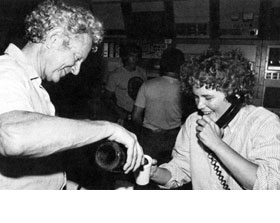Saver Reaches Goal, Sets Energy Record!
The Energy Saver has reached its primary design goal: accelerating protons to 500 GeV in a ring of superconducting magnets. In fact, the energy was 512 GeV--a new world record for accelerators. The record was set at 3:37 p.m., Sunday, July 3, only 13 hours after the first serious attempt to accelerate beam above the injection energy of 150 GeV.
News of this historic achievement spread rapidly-by telephone and telex to all quarters of the world. The Control Room rapidly filled with off-shift workers and other well-wishers as the champagne was broken out.
The events leading up to this milestone followed the usual pattern of a long pause while a blockade to progress was diagnosed, followed by sudden leaps forward. Difficulties in achieving coasting beam at 150 GeV, reported two weeks ago, were finally tracked to a misdesigned flange in the C0 straight section and a Kimwipe left in the bore tube in A0. After the Kimwipe was removed on June 25, coasting beam was rapidly achieved. The rf cavities were proven capable of maintaining the bunching at 150 GeV and even accelerated the beam slightly.
There followed a two-day down period for necessary repairs with the expectation that acceleration towards 500 GeV would begin soon after startup on June 30. Unfortunately, the weather did not cooperate. A lightning bolt struck service building E0 at 3 a.m. on Friday, July 1, damaging enough sensitive electronics to cause six hours of diagnosis and repairs, followed immediately by more lightning-induced trips around 9:30 a.m. The next night torrential rains found their way all the way to electronics racks.
When all was finally ready to attempt acceleration, beam reached the top of the 250 GeV ramp on the very first pulse at 3:12 a.m., Sunday, July 3. After a shift of studies at that energy, the current ramp in the magnets was reset to 400 GeV and beam accelerated to that energy at 1:38 p.m. A "go for the record" spirit then prevailed; after readjusting the ramp again, the energy goal was exceeded amidst jubilation at 3:37 p.m.
As this issue goes to press, the Doubler is holding at 512 GeV and low intensity to make systematic measurements of beam characteristics. The energy is already more than needed for the 400-GeV run for physics experiments scheduled for October of this year. The next important tasks for the Doubler are to increase the intensity and master extraction of a high intensity beam to the Experimental Areas. Rich Orr commented, "We are sweating blood to make our end work. I hope the experimenters will be ready in the fall - although we still have a long way to go.
ResolutionAt its Friday, June 17, meeting at Fermilab, the Universities Research Association (URA) Board of Trustees voted by acclamation the following expression of recognition of the Laboratory's attainment of an initial beam in the superconducting ring:
"Be it resolved that the Board of Trustees of the Universities Research Association congratulates the Director and staff of the Fermi National Accelerator Laboratory for reaching an impressive milestone of the Saver project in record time. In particular we wish to acknowledge the singular accomplishments of Dr. Rich Orr and Dr. Helen T. Edwards in leading this distinguished effort."
This was submitted to Leon Lederman by Dr. H. Guyford Stever, president of URA, in a letter dated June 23.




